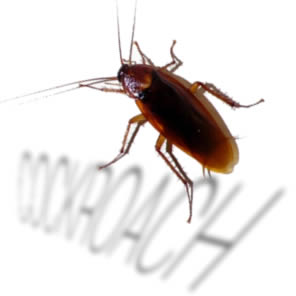Cockroaches
German cockroach, Blattella germanica
Key features
The adult is light brown in color with two dark almost
parallel longitudinal stripes on the pronotal shield.
The female is darker than the male and with a broader
abdomen.
Both male and female adults are fully winged. Early
instar nymphs have a pale area centrally on the dorsal thorax. Later instars have two longitudinal stripes on the pronotum.
Biology
The ootheca is carried by the female until it is in within 1 - 2 days of hatching. Small first instar nymphs emerge from the ootheca and easily infest tiny cracks and crevices in the immediate area.
All the nymphal stages and the adults feed on the same type of food, making the establishment of an infestation extremely easy.
Prior to molting, nymphs become immobile, remaining in harborages.
Significance
German cockroaches are found throughout buildings but show a preference to warm humid areas. They are good climbers, being able to climb vertical glass or tiled surfaces. An infestation of these cockroaches can be quickly established once they have entered the premises. This species is an extremely serious pest in any different types of premises ranging from hospitals to domestic houses.
Adult size: 13 -16 mm
Number of molts: 5 - 7
Development time (Egg to adult): 1 - 3 months
Length of adult stage: 3 - 6 months
No of oothecae produced in female lifetime: Average 5 / Range 4 - 8
No of eggs produced per ootheca: Average 30 - 40 / Range 18 - 50
Cockroaches
Control Methods
An established cockroach infestation is likely to be difficult to control. This is because the cockroaches will be distributed throughout the building in difficult to reach harborages. Furthermore the phenomenal breeding potential and production of many egg cases by each female cockroach means that unless a very high proportion of the population is eliminated, numbers will continue to increase.
An integrated programmed approach is essential. Spot treatments will be completely ineffective for all but a small, localized infestation.
Before a treatment is carried out, it is important to identify the cockroach species. This will provide details of the biology, life cycle and habits of the pest, which can be exploited in the control programmed.
Monitoring the extent of the infestation by visual inspection of voids, potential harborages and the use of traps will help identify hotspots of infestation. Inspections are best carried out at night when the cockroaches are more active. A torch fitted with a red filter should be used, as cockroaches do not respond to red light. Aerosols may aid in flushing out insects from their harborages.
When using sticky traps, suitable placement sites would be underneath equipment, behind counters, in roof spaces and in ducting and electrical .
As cockroaches become trapped, the trap becomes more attractive to other cockroaches because of the effects of aggregation pheromones exuded by the trapped cockroaches. Adjoining building and areas sharing services should be included in the monitoring.
Non-chemical control methods, such as removal of food and water residues, proofing, improving hygiene and creating access to difficult-to-reach areas, will all aid a successful cockroach control programmed.
If chemical control is needed, a combination of different formulations for different areas will give the most effective
Treatment
Care should be taken to select only those insecticides which are approves for use against cockroaches and that the area of approval covers the type of building to be treated.
Insect growth regulators, baits, residual insecticidal sprays, insecticidal dusts and ULV formulations may all be considered and most usually a combination of all or some of them will be selected. Use of one type of formulation alone in a complex building is unlikely to achieve a sufficiently high level of control. Re-treatment of all or some areas will almost certainly be needed. A thorough treatment is needed.
After insecticidal application, post treatment monitoring should be carried out and steps should be taken to prevent re-infestation, by attempting to determine the source of the original infestation.
For instance, are oothecae or cockroaches being introduced on incoming goods, laundry, potted plants or via drains?
Continued use of sticky traps as a permanent early warning system may also be useful.






